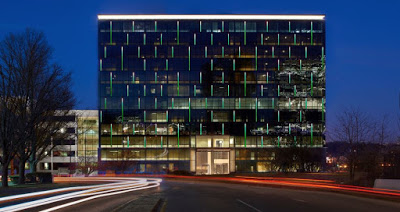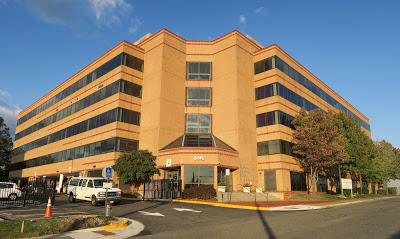New uses could revive old office buildings
 |
| The Silverline Center in Tysons [Hickok Cole Architects] |
Fairfax County needs to make it easier for developers to convert aging, underutilized office buildings to new, more profitable uses, states a report released this month by the Fairfax County Building Repositioning Workgroup.
The workgroup was established by the Board of Supervisors in fall 2015 to examine the conditions that contribute to office building obsolescence and identify repositioning and repurposing solutions.
 |
| Bailey’s Upper Elementary School |
The group was chaired by Supervisor John Cook (Braddock) and included real estate developers, building owners, nonprofit advocates, representatives of the Fairfax County Economic Development Authority, and county staff.
Since 2010, job growth in the county has been strong, the report states. The unemployment rate was just 3.2 percent in July 2016, well below the national rate of 4.9 percent. And there is demand for new offices, with nearly 2.5 million square feet under construction.
At the same time, the amount of vacant office space has been climbing. The vacancy rate peaked at 16.2 percent at the end of 2015, and there is 18.8 million square feet of office space available, most of it in aging Class B and Class C buildings with fewer amenities than Class A buildings.
The report doesn’t break down the location of these buildings, but it’s clear that there are many aging offices in Mason District. Bailey’s Crossroads and Seven Corners have much higher vacancy rates than the county average.
One factor leading to the oversupply of office space identified by the workgroup is the increase in teleworking and more efficient office design, leading to less of a need for leased office space per employee. Also, employers are relocating to buildings with more amenities closer to transit options, putting older buildings in office parks at a disadvantage.
The workgroup identified several strategies for addressing building vacancy:
- Repositioning – Upgrading an aging building and its systems and adding amenities.
- Repurposing – Converting an office building to residential, institutional, or other uses.
- Accommodating emerging trends – Adopting such new uses as co-working, co-living, makerspaces, food incubators, urban farming, and flexible live-work arrangements.
One small-scale example cited in the report is the Play, Work or Dash facility, which offers childcare and office space,
According to the workgroup’s survey, there are 182 buildings in the county that fit the group’s size, age, and location parameters, making them suitable for conversion to residential uses. Those buildings are between 75,000 and 300,000 square feet, built between 1985 and 2005, and near activity centers. When other factors, such as the floor plan, ceiling height, and construction materials, are considered, the number is reduced to 10 to 30.
The workgroup proposed the following recommendations to encourage the repositioning and repurposing of old office buildings:
- Modify the zoning ordinance to facilitate flexible uses office buildings.
- Improve and simplify the proffer and occupancy permit processes.
- Provide more guidance in the policy plan portion of the Comprehensive Plan.
- Provide information about the potential for reusing buildings to developers, property owners, and real estate brokers, and create a database of common issues and solutions.
The report highlights several examples of creative projects in the D.C. region:
Bailey’s Upper Elementary School in Seven Corners, Fairfax County’s first urban design school, was opened in 2014 in what had been a five-story office building built in 1987.
The Silverline Center in Tysons includes the repositioning of the 1973 Tower Building, with such improvements as an upgraded façade, renovated lobby, childcare facility, conference center, bike storage room, outdoor pedestrian connections, and ground-floor restaurants. The project cost $35 million, and the assessed value went from $80 million in 2015 to $141 million in 2016.
WeWork Dupont Circle provides co-working space for individuals with high-speed internet, printers, a game lounge, and conference rooms in a 12-story building on Connecticut Avenue in Washington, D.C.
WeLive Crystal City in Arlington offers 216 furnished residential units arranged into “neighborhoods” with communal lounges and kitchens. Located in a renovated 1965 building, it’s a combination of individual apartments and group living.
NOVA Labs, in a 1968 building in Reston, provides rental space for small-scale manufacturing and also has classrooms, business incubator offices, and space for community events.
A single-story former warehouse in Lorton has been transformed into Frontier Kitchen with rental space for caterers, bakers, food truck operators, and other food entrepreneurs.
An office building in Alexandria has been converted to e-Lofts, a flexible concept where tenants can rent units for living, working, or both. The Fairfax County Board of Supervisors approved a similar e-Lofts project earlier this month for a vacant office building in Bailey’s Crossroads.


Residents tried to get on this committee to give our perspective since a majority of vacant office buildings are in Mason District. However, we never received a response back from from Supervisor Cook's office. They only wanted developers, owners, real estate lawyers, and county staff to be on it. Typical.
Of course, what we need is to make everything more friendly to developers. After all, they ruined the area and lined the pockets of the members BoS. Good show!!!
Great building at Tysons, really makes you want to go there. Unfortunately there is nothing even close to that in Baileys. Except for the horrible suds or rama or whatever you call the place. Its where there use to be a nice Italian restaurant up on the hill by Baby's R Us. It use be lit up and presented a nice gateway into Baileys.
And Gross thinks we had a wonderful 2016, maybe doing laundry!
It was a brazilian BBQ place before the laundromat. That being said the place was vacant for a long time before the current tenant took it.
There was an Italian restaurant before the Brazilian. It was a mid to high priced elegant establishment. That is before Baileys started declining into a ghetto.
How about providing arts spaces in buildings that haven't been renovated yet? Isn't temporary low rent better than vacant space? Or space in office, home or flex spaces with a room for yoga, tai chi or other movement classes before and after work and at lunch?